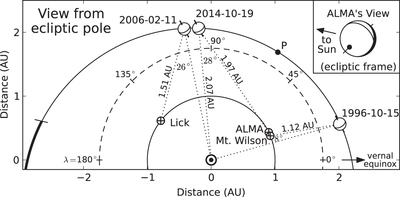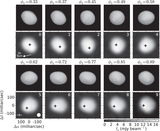Image Details

Caption: Figure 1.
As viewed from the ecliptic pole, this diagram shows the alignment of Earth and Juno in their respective orbits on the three dates of observational data discussed: ALMA (this paper), Mt. Wilson Observatory (Baliunas et al. 2003), and Lick Observatory (Drummond & Christou 2008). The scale of heliocentric ecliptic coordinates (λ, β) is indicated by the dashed line circle. The three angles inside the dotted lines correspond to the Sun-target-Earth angle that describes the solar illumination phase. The nominal rotational pole (toward ﹩\lambda =118^\circ ,\beta =+30^\circ ﹩; Drummond & Christou 2008) and its corresponding equator are drawn onto a spherical representation of Juno for reference. Juno's perihelion at ﹩\lambda =58\buildrel{\circ}\over{.} 3﹩ is marked by the dot labeled “P.” The portion of the orbit above the ecliptic is shown by the thick line, which begins at the ascending node (﹩\lambda =+169\buildrel{\circ}\over{.} 9﹩). Inset: the point of view of the ALMA observations (in the ecliptic coordinate frame), which is dominated by the southern hemisphere. Juno's south pole and equator are marked, as is the evening terminator and unlit side that reflects Juno's solar phase angle and heliocentric latitude (﹩\beta =-13\buildrel{\circ}\over{.} 2﹩ viewed from Earth) at the time of observation.
Copyright and Terms & Conditions
© 2015. The American Astronomical Society. All rights reserved.





